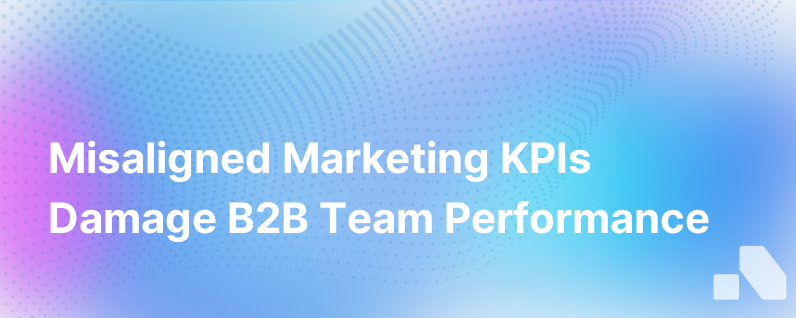
In the competitive B2B arena, one of the most crucial, yet often overlooked, elements of a successful strategy is the alignment of key performance indicators (KPIs) across sales and marketing teams. The alignment of these KPIs is not just about data or numbers; it is about creating a shared language and understanding that drives collective efforts toward common goals. Without this alignment, marketing and sales efforts can become disjointed, leading to inefficiencies and missed opportunities.
The Misalignment Issue and Its Impact
When marketing KPIs are not in tune with the overarching company objectives or sales targets, the outcomes can have a domino effect on the business. Here are some key issues that arise from misaligned marketing KPIs:
-
Wasted Marketing Spend: The absence of aligned KPIs leads to marketing budgets being spent on campaigns that don't contribute to the bottom line or sales objectives. For instance, a focus on vanity metrics such as likes or shares does not necessarily translate to qualified lead generation or customer acquisition.
-
Poor Sales Enablement: Marketing efforts that are not aligned with sales objectives fail to equip sales teams with the right tools, content, and insights needed to close deals. If marketing is measured on lead quantity rather than lead quality, sales teams waste time sifting through unqualified prospects.
-
Mismatched Messaging: When marketing goals are not in line with the strategic vision of the sales team or the company's value proposition, it can result in inconsistent and confusing messaging to the market, diminishing brand identity and trust.
-
Inefficient Lead Conversion: Misaligned KPIs can result in focusing on leads that aren't in the sales target or ideal customer profile, leading to poor conversion rates and elongated sales cycles.
-
Revenue Forecasting Errors: Misalignment can also lead to inaccurate revenue projections. Without an understanding of the sales conversion pipeline, marketing efforts are not measured against revenue, leading to optimistic forecasting that may not align with the ground reality.
-
Decreased Customer Lifetime Value: Marketing strategies disconnected from customer retention and expansion opportunities can contribute to a lower customer lifetime value. It's not only about customer acquisition; retention and upsell/cross-sell strategies are vital in the B2B landscape.
-
Strained Interdepartmental Relationships: The lack of shared KPIs often leads to blame games between sales and marketing, causing a rift in team dynamics and collaboration.
Aligning KPIs for B2B Success
Effective KPI alignment begins with a comprehensive understanding of the business objectives and how each department's activities contribute to the end goal. Here are steps B2B organizations can follow to ensure KPIs across marketing and sales are harmonized:
-
Develop Joint Objectives: Sales and marketing should work together to define unified objectives that support the overall business goals, such as revenue targets, market penetration, or customer retention rates.
-
Choose Relevant KPIs: Select KPIs that are indicative of business growth and are actionable. For example, instead of only tracking website traffic, measure the conversion rates of traffic to leads and leads to customers.
-
Foster Cross-Departmental Collaboration: Regularly scheduled meetings between sales and marketing teams can help ensure that both are on the same page, with KPIs frequently discussed and adjusted as necessary.
-
Use Lead Scoring: To gauge the quality of leads, implement a lead scoring system that evaluates and ranks prospects according to their likelihood to buy. This ensures marketing efforts are evaluated based on the delivery of sales-ready leads.
-
Embrace a Customer-Centric Approach: Align your KPIs around the customer journey. Understand the touchpoints and experiences that lead to conversions and customer advocacy, and focus on metrics that enhance these experiences.
-
Implement a Feedback Loop: Create mechanisms for continuous feedback from sales to marketing on the quality of leads and the effectiveness of marketing collateral. Use this feedback to tweak campaigns and improve alignment.
-
Adopt a Data-Driven Culture: Utilize robust analytics and CRM tools to track and analyze KPIs in real time. Use this data to make informed decisions and adjustments to campaigns and strategies.
-
Celebrate Shared Success: When both teams are working towards common KPIs, celebrate the wins together to reinforce collaboration and shared ownership of results.
Tools and Technologies to Assist in KPI Alignment
Advanced tools can significantly aid in aligning KPIs. Platforms like Salesforce, HubSpot, and Marketo provide comprehensive analytics and reporting features that align sales and marketing data, making it easier to measure shared KPIs and visualize department overlap. Additionally, communication tools like Slack also help keep both teams in sync, allowing quick resolution of discrepancies in data interpretation or campaign execution.
The Aomni Advantage
At the core of these efforts lies the need for cutting-edge solutions that streamline data analysis and facilitate real-time decision-making. Aomni is uniquely positioned to fulfill this role. Our AI-powered platform enables seamless synergy between sales and marketing teams, providing actionable insights and a unified view of account metrics. With Aomni, you can mitigate the risks of misaligned marketing KPIs, ensuring each campaign drives value and aligns with broader business objectives.
To conclude, B2B organizations must realize that the strategies that win are those built on a foundation of aligned KPIs. By ensuring that marketing and sales are united by common metrics, companies can operate efficiently, optimize ROI, and forge a path of sustainable growth.